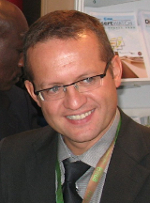Questions for Marc Paganini, Directorate of Earth Observation Programmes at the European Space Agency
 Could you please explain rapidly the role of the European Space Agency, its past and present involvement in geomatics, and its interest in these tools?
Could you please explain rapidly the role of the European Space Agency, its past and present involvement in geomatics, and its interest in these tools?
Since the Johannesburg Earth Summit in 2002, the European Space Agency has been actively engaged in helping international environmental agreements and their contracting parties use satellite imagery. Combating the collapse of biodiversity is a crucial sustainable development issue, and earth observation satellites are essential tools for assessing and monitoring the condition of ecosystems and the ecological services they provide. The European Space Agency has become a key partner in this process, and a stakeholder committed to the Ramsar Convention on Wetlands. For over 10 years, we have funded a large number of research projects and studies, which have made it possible to establish practical guidelines for using satellite imagery for more effective wetlands monitoring.
How has the ESA worked with the Tour du Valat in the past on geomatics, and how will this collaboration continue now and in the near future? And in your opinion, what concrete achievements have been made in terms of the conservation of wetlands in the Mediterranean Basin?
Due to its geographic position, the European Space Agency has always been very active regarding the major challenges facing the Mediterranean Basin, such as coastal problems, agricultural development, demographic pressure, and the loss of resources and natural habitats. We started working with the Tour du Valat in 2008 at the 10th Conference of the Contracting Parties to the Ramsar Convention, in South Korea. The Tour du Valat had just announced the creation of the Mediterranean Wetlands Observatory (MWO), and the ESA was seeking to set up a regional pilot project for the Ramsar Convention. Our collaboration resulted in the GlobWetland-II project in 2009, in which staff from the Tour du Valat and from countries in North Africa were trained to use satellite images and remote sensing to monitor their wetlands. The major outcome of this cooperation is the publication by the Tour du Valat of a substantial and significant report on spatial dynamics in coastal Mediterranean wetlands (rajouter les refs et lien du rapport).
Last June, the European Space Agency successfully launched the new Sentinel-2a satellite, from Kourou in French Guiana. How is the Sentinel project expected to develop in the near future, and what progress should it make possible in terms of geomatics?
Sentinel-2a is the second satellite sent into orbit by the ESA as part of the EU Copernicus programme for observing the Earth. This programme is being jointly conducted by the European Commission and the European Space Agency. It aims to provide continuous satellite observations for the different disciplines concerned, which range from the surveillance of land and marine environments, to the management of natural catastrophes, the monitoring of the earth’s atmosphere and climate change, and even the security of common citizens. The EU has made a long-term commitment to providing these observations, with a calendar already set up until 2028. Sentinel 2 was designed to be the ideal observer of wetlands. With a swath width of 290 km, spatial resolution of 10 m, and a multi spectral imager (MSI) covering 13 spectral bands in the visible and near infrared bands, it will provide continuous monitoring of all wetlands every 5 days in its current operational configuration with two satellites in orbit.
Geomatics benefits from the rapid progress made in IT and satellites, which makes it possible to easily provide scientists with very high quality data. How do you see the evolution of these technologies in the long term, particularly in terms of how they will help to conserve the environment in general and wetlands in particular?
In recent years, our governments have radically changed their space policies. Public investment in Earth observation programmes has increased significantly, and has been defined in terms of free access to satellite data. While the United States has just adopted an Earth observation programme that will continue the work carried out during the Landsat missions, with its Copernicus programme, Europe has made a commitment to put in place a set of global surveillance services that should protect the environment and ensure our security. The major challenge is to transform all of these observations into concrete advantages for our societies. The rapid development of information technologies and data analysis tools should enable us to meet the challenges involved in processing the enormous amounts of data captured and how our institutions use them in their decision-making processes.